
Since 2013, the Dodgers have been more successful at winning games during the regular season than at any time in their history. I would like to look back at the previous teams and see how the team and the game have evolved. There were teams in Brooklyn prior to the National League forming in 1890 but they were members of the American Association. The first AA team came into existence in 1884. There were 13 teams in the Association at that time. Brooklyn finished 9th. 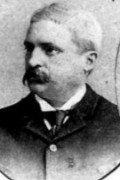
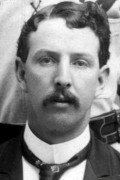

The team would spend six seasons in the AA. At the time, they had no official nickname and on the baseball reference page, they are simply referred to as Brooklyn. In their first four seasons they never got closer than 16 games out of first place. In 1888 that changed and they played .600 ball for the first time in team history. They changed managers from Charlie Bryne to Bill McGunnigle. That is Bryne in the top photo, then McGunnigle and the AA logo. 
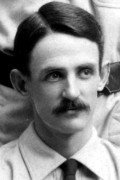
The would finish second in what now was an 8-team league. The St. Louis Browns finished 6.5 games in front of them. They were led by pitcher-outfielder, Bob Caruthers who won 29 games. Their most productive hitter was George Pinkney, a third baseman who led them in runs scored and tied for the lead in hits with 156. Caruthers led the team in homers with 5. Dan Foutz, their first baseman, had 99 RBI’s and tied with Pinkney for the team lead in hits. Foutz also pitched in 23 games with a 12-7 record. Mickey Hughes, who was 21, won 25, lost 13. Adonis Terry, a 23-year-old at the time, won 13. Terry top photo, Caruthers bottom.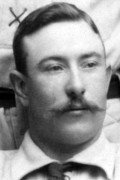

The next season, they had so many new husbands on the team that they began being called the “Bridegrooms. They would win the AA pennant for the first time then lose to the New York Giants in a championship series. Caruthers won 40 games. Terry won 22, Lovett 17 and Hughes 9. Foutz was 3-0 in his 12 games. Foutz drove in 113 runs, and Thomas “Oyster” Burns 100. Darby O’Brien, the second baseman hit .300 and led the team in hits with 146. Joe Visner, a utility player, and John Corkhill, an outfielder, each had 8 homers to lead the team. Oyster Burns, top photo, Foutz bottom.
In 1890, the National League was formed with eight teams. Brooklyn, the Chicago Colts, Philadelphia Phillies, Cincinnati Reds, Boston, New York Giants, Cleveland Spiders, and Allegheny City. The legacy of the Dodgers in the National League began.
1890’s
The team was still called the Bridegrooms. They won 86 games an finished 6.5 games in front of the Colts. O’Brien hit .314 to lead the team. Pinkney and Foutz also batted over .300. The power guy was Oyster Burns, he hit 13 homers and drove in 128 runs, 30 more than the second place Foutz. Lovett led the team in wins with 30. Terry won 26 and Caruthers 23. Hughes won just 4 and would be gone the next season at the age of 24. They tied the Louisville Colonels of the AA in a championship series. There was no World Series as we know it now, that did not begin until the 1900’s. 
1891: From 1891-94, the team had no nickname. The 91 squad had a new manager, John Ward, and finished with a 61-76 record in 6th place. To show how much different things were, they had a six man pitching staff. Dave Foutz, the 1st baseman, was the only position player who also pitched. Ward was also the teams SS. Lovett led the team with a 23-19 record. Bob Caruthers was the only other pitcher with double digit wins, 18. Their leading hitter was Oyster Burns, .285/4/83. Darby O’Brien led the team with 5 homers.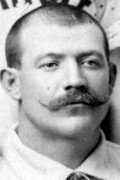

1892: The team improved dramatically with a 95-55-4 record and a 3rd place finish in a 12-team league. Boston won 102 to win the pennant and Cleveland finished second with 93 wins. Because they had no ties, their winning percentage was higher than Brooklyn’s. Dan Brouthers, now 34, put up one of his best seasons, .335/5/134. He had 197 hits to lead the league, and long before we started measuring such things, he had a 8.8 WAR, and OPS of .911 and a 179 OPS+. He led the league in all of those categories plus hits, RBI’s and BA. He also had 20 doubles. Ward led the league in stolen bases with 88. As a team they stole 409! George Haddock won 29 games, Ed Stein 27, and the young Brickyard Kennedy, 13. Brouthers top photo. Haddock lower photo.
1893: Dave Foutz took over as the manager, and the team slipped down to 7th place with a 65-63-2 record. Brouthers was again their best hitter with a .337 mark. Tom Daly, the second baseman led the team with 8 homers. Kennedy was the star pitcher with 25 wins, Stein contributed 19. They stole 213 bases, quite a drop from the year before. 
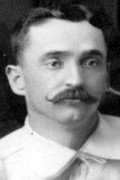
From 1894-98, they managed just two seasons above .500. In 1895, they had the nickname Grooms, which stuck until 1898. Foutz would manage the team until 1897. In 1898, They finished with a 54-91-4 record under three different managers. The last one that season was one Charles Henry Ebbets, better know as Charlie. He wasn’t particularly good as a manager 38-68-4, but he would make his mark as the owner of the Dodgers beginning in January of 1898 when after his partner, Charles Bryne died. Ebbets actually owned 80% of the teams stock, but Bryne was the teams CEO until that point. In 1899, the team flipped their fortunes again, winning 101 games under new manager, Ned Hanlon. They were now called the Superbas, after a popular traveling entertainment troupe.

Their best hitter was Wee Willie Keeler. The future Hall of Famer hit .379. Joe Kelley, another future member of the Hall of Fame, batted .325. He also led the team in homers with 6, and RBI’s with 93. They used 17 position players over the course of the season, and 11 pitchers. Three pitchers posted 20 or more wins. Jay Hughes led with 28, Jack Dunn won 23, and Brickyard Kennedy 22. The team stole 271 bases led by Keelers 47. Ebbets would soon build their first permanent home, a stadium they would stay in up until they moved west in 1958, Ebbets Field. But that was in the future.
1900-1909.
The Superbas started off the new century by finishing first and winning their second pennant in a row. The NL now consisted of 8 teams, Brooklyn, New York, Pittsburgh. Philadelphia, Boston, St. Louis, Cincinnati and Chicago. It would remain that way until the Boston franchise moved to Milwaukee in 1953. Brooklyn won by 4.5 games over the Pirates. Keeler led the league with 204 hits and batted .362. Kelley .319, Jones .310, and Daly .312, were the leading hitters. The team stole 274 bases with Keeler’s 41 leading the way. Kelley with 6 homers and 91 driven in was the team leader in both stats. Joe McGinnity led the league with 28 wins. He also led in walks and hit by pitch. Kennedy added 20 wins. It was Iron Joe’s only season in Brooklyn in his Hall of Fame career. 



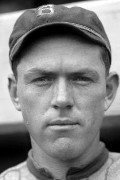
Hanlon would manage Brooklyn until 1905. But he never could quite get the team back into first place. In 01 they were 3rd, 02 2nd. 5th in 03 and 6th then 8th in 04 and 05. He was replaced by Patsy Donovan for the 1906 season. Donovan had some good players like outfielder Harry Lumley who hit .324. But they hit just .231 as a team. Their top pitcher, Doc Scanlan, won 18 and lost 13. He was the only pitcher with a record above .500. 1907 was not much better. They finished 5th again, winning just 1 game less than in 06. Lumley led the team with 9 homers and 66 driven in but hit just .267. Their best pitcher was LH rookie, Nap Rucker who was 15-13 with a 2.06 ERA. Photos top to bottom: Donovan-Lumley-McGinnity-Scanlan-Rucker.  1908 and 09 were just as bad. In 1908, they lost 101 games, second time in four years they did that. They hit just .213 as a team and scored 375 runs. Tim Jordan led the league with 12 homers. As a team they hit just 28. Jordan was also their best hitter with a .247 BA. Nap Rucker, 17-19, was the closest hurler to a .500 record. In 09 they were 55-98. Harry Lumley had taken over as manager. Their BA improved to .229. They only hit 19 homers all year and scored 442. Their WAR as a team was 3.9. George Bell had a 16-15 record. Rucker was 13-19 but his ERA was 2.24. Things would not be much better for them as the 1900’s headed into its second decade.
1908 and 09 were just as bad. In 1908, they lost 101 games, second time in four years they did that. They hit just .213 as a team and scored 375 runs. Tim Jordan led the league with 12 homers. As a team they hit just 28. Jordan was also their best hitter with a .247 BA. Nap Rucker, 17-19, was the closest hurler to a .500 record. In 09 they were 55-98. Harry Lumley had taken over as manager. Their BA improved to .229. They only hit 19 homers all year and scored 442. Their WAR as a team was 3.9. George Bell had a 16-15 record. Rucker was 13-19 but his ERA was 2.24. Things would not be much better for them as the 1900’s headed into its second decade.
1910-19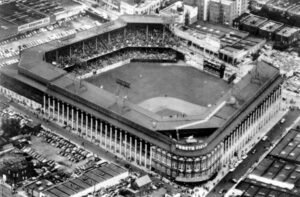
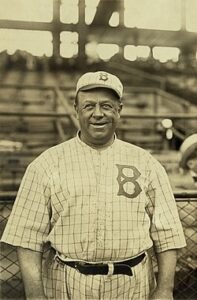
1910 brought another new manager, Bill Dahlen. The team finished 6th, 64-90-2. It was the debut year of leftfielder, Zack Wheat. The 22-year-old batted .284 to lead the team. Jake Daubert led the team with 8 homers. They batted .229 again. They scored 497 runs. Rucker was 17-18. Bell lost 27 games. They were under .500 the next four years. In 1913, they moved into their new ballpark, Ebbets Field. Dahlen would manage the team until 1914. That year, Wilbert Robinson, a former catcher, took over the reins of the Dodgers. They won 75 and lost 79. Their best record since 1902. In 1915, they were over .500 for the first time since 1901. 80-70-2. 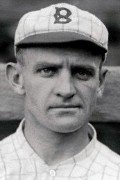
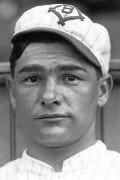
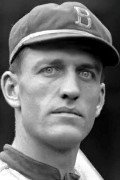
Wheat led the team with 5 homers, Daubert led all the regulars with a .301 average. They finished 3rd. Also on that team was a young outfielder named Casey Stengel. Jeff Pfieffer was the Ace of the pitching staff, which posted a team 2.66 ERA. Pfieffer was 19-14 with a 2.10 ERA. In 1915 the team began to be called the Robins, after Uncle Willie, which was the nickname the players hung on their manager. Stengel, Wheat, Daubert.
In 1916, they did something they had not done since 1900. They won the pennant. Daubert and Wheat led the team in BA at .316 and .312 respectively. Wheat led the team with 9 homers. Stengel added 8. As a team they hit .269 and stole 187 bases. Pfieffer was 25-11 with a 1.92 ERA. They had a team ERA of 2.12. They went to their first World Series playing Babe Ruth’s Boston Red Sox. Ruth pitched in game two, and after allowing a run in the first, he shut them out for the next 13 innings. With one out in the bottom of the 14th, the Sox pushed across a run for the win. Brooklyn won just game 3 behind Jack Combs who beat Carl Mays. Pfieffer got the save. In case you were wondering, the Bambino went 0-5 in the series with 1 RBI. He would add to his 13 inning of scoreless baseball in World Series games in 1918 against the Cubs setting the record with 26 consecutive scoreless innings. Stengel was Brooklyn’s best hitter in the series going 4-11.
The last three years of the teens, they finished 7th then 5th twice, never closer than 5.5 games. Zack Wheat had established himself as the team’s best player. He would win a batting title in 1918. The US was at war, but the games went on. The team was hopeful that the 20’s would bring better fortune. They had some good players, Jimmy Johnson, Hi Myers, Burleigh Grimes.
1920-29
They started off the 20’s right winning the National League pennant by seven games with a 93-61 record. The Giants finished 2nd. Their pitching led the way, future Hall of Famer, Grimes, was 23-11. The team had a 2.62 ERA. Grimes ERA was 2.22. He had a team high 8.4 WAR. Twice as high as any other player on the team. Six of the 9 pitchers the team had won 10 or more games. They batted .277 as a team. They were not very fleet on the bases getting caught more than they stole, 80-70. 
Wheat led the team with a .328 average. Myers and 1st baseman, Ed Konetchy both hit over .300. Wheat led the NL in triples with 22. Grimes hit .306 They faced the Cleveland Indians in the World Series. Brooklyn would lose the series, 5 games to 2. They were shut out the last two games. Grimes suffered 2 of the losses and won game 2. In game five, Bill Wambsganss did something that has never happened again in a World Series. He made an unassisted triple play. It was a game of firsts. Grimes gave up the first grand slam in series history in the first to Elmer Smith, putting Brooklyn in a deep hole. 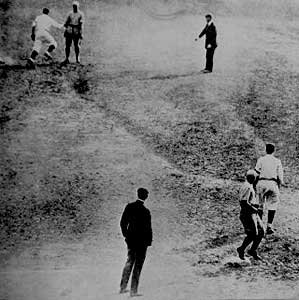
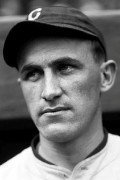
This was pivotable game since the series was tied at 2 wins each. In the top of the fifth, Kilduff and Otto Miller singled. Clarence Mitchell, who had replaced Grimes stepped up to the plate. He hit a line drive that Wambsganss had to move to his right for and leap to catch. The runners were moving. Wamby stepped on second and saw Miller barreling towards him and tagged him out for the triple play. Brooklyn only hit .205 for the series. Cleveland hit 2 homers, Brooklyn none. It would be their last trip to the big dance for 21 years.
From 1921-29 they finished 5th, 6th twice, 2nd in 24, their only winning season. They were 1.5 games behind the Giants. From 25-29 they were consistent; they finished 6th each year. Jimmy Johnson and Zack Wheat were their best players. Grimes was winning 20 almost every year. But as a team, they were not very good. Wilbert Robinson stayed as the manager through all of those bad seasons. Today he would have been fired after one bad one and a bad start the next year. Different era and mindset.
Charlie Ebbets died in April of 1925, Steven McKeever and the Brooklyn Trust Company took control of the team. McKeever passed in 1928, and James and Dearie Mulvey along with Ebbets second wife, Grace took control of the team. Future Hall of Famer Dazzy Vance joined the team in 1922 and immediately became the Ace. Wheat played his 18th and final season in Brooklyn in 1926. As Wheat was ending his Brooklyn career, one of the better hitters in Dodger history made his debut. The Dodgers own Babe, Herman. Then the stock market crashed in October of 1929, and baseball, along with most every other form of entertainment, would struggle to get people’s hard-earned money spent attending games.
1930-39
The 1930 Robins shocked everybody, including themselves as they had a winning record and finished 4th with a 86-68 mark. Herman, now 27 had one of the best seasons of any hitter in Dodger history. He batted .393 with 35 homers, and 130 driven in. He struck out just 56 times and walked 66. He added 48 doubles and 11 triples. He even stole 18 bases. He was caught 13 times though. As a team they hit .304. They hit 122 homers and scored 871 runs. Vance won 17, lost 15 and had an ERA of 2.61. 
In 1931 a couple of things happened. First, they finished 4th again. Herman came back to earth and hit .313 with 18 homers. Lefty O’Doul led the team with a .336 average. They scored over 100 runs less and the team BA dropped close to 30 points. The pitchers despite having a lower combined ERA than in 30, was not that good. At the end of the season, Wilbert Robinson left as manager and future Hall of Famer Max Carey got the job. He would not have it long, just 2 years. Van Mungo was the staff Ace. Vance was 41 and in his last season in Brooklyn.
It was all downhill after that. 6th in 33, 6th in 34 with new manager Casey Stengel. 5th in 35. 7th in 36 with Casey still in charge. A managerial change in 37 with Burleigh Grimes taking over, and a 6th place finish. They also had green caps and letters on the uniform that year. Steve McKeever died in 1938, the Mulvey’s inherited his shares. The Brooklyn Trust Company is important because in 1933 a young lawyer joined the company to protect their financial interests which included the estate of Charlie Ebbets. That young lawyer would eventually become the majority owner and forever change the franchises future when he moved the team west in 1958. Walter O’Malley.
They hired Babe Ruth as a coach in 1938. Ruth believed he would become the manager after Grimes. But he was more of a sideshow, taking batting practice. Larry Macphail, who had previously worked for the Reds, was promoted to team president. He set about changing the culture of the team. The star of the team was Dolph Camilli. Leo Durocher was the SS. They were 69-82-2 and finished 7th. 1939 brought a new manager, Leo Durocher. Macphail brought in players like Dixie Walker, Mickey Owen, Hugh Casey. The team finished 3rd in 39. Their best finish since 32. The new decade would bring a World War, and changes to a franchise that would wash over to the 50’s bringing an unprecedented era of success.
1940-49
1940 saw the Dodgers finish second. Camilli was still the star, but he got help from Walker and Joe Medwick. They picked up a kid SS who was slated to replace Durocher as the everyday SS. His name was Harold Reese, better known as Pee Wee. Whit Wyatt and Freddie Fitzsimmons were the staff leaders. They would get a kid the next year who would be a spark plug and play CF like his life depended on it, Pete Reiser. 1941 would end 22 years of frustration. 
1941. The Dodgers would win their first pennant since 1920. They won 100 games and finished two and a half games in front of the Cardinals. Dolph Camilli had an MVP season. He led the league in homers with 34 and RBIs with 120. Rookie Pete Reiser hit .345 to win the batting title. He also led the league with 17 triples. Dixie Walked hit .311 and Medwick, .315. Reiser had an 8.0 WAR. Kirbe Higby and Whyatt won 22 games each. The team scored 800 runs despite hitting just 101 homers. They would lose the World Series to the New York Yankees, 4-1 getting their only win in game 2. They were ahead 4-2 in the 9th inning of game 4 when Mickey Owen missed strike three. The Yankees then scored 5 runs to take a 3-1 lead in the series. They lost game 5, 31-. 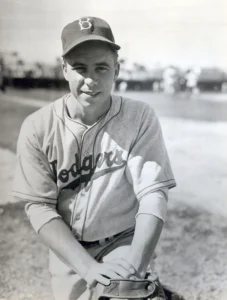
By 1942, the US was at war after being attacked in December of 41. Some players had already enlisted in the armed forces. The Dodgers star players had not yet done that. They would win 104 games and finish second to the Cardinals. Seven Dodgers would make the All-Star team. Reese, Owen, Herman, Arky Vaughn, Medwick Reiser and Wyatt. Reiser led the league in steals with 20. Wyatt won 19 to lead the team. They hit .264 but hit just 81 homers. In 1945, O’Malley, Rickey and Lawrence Smith bought out the Ebbets estate. MacPhail had left to join the military, and Rickey took over the everyday operations of the team. He also started building the Dodger farm system to match the Cardinals.
1943-46 they were competitive except for 44 when they finished 45 games out of first. They had two third place finishes, 43-45, and finished 2nd in 1946 when players began returning from the war. Reese, Reiser, Furillo, Hodges, players who would play a major role in the late 40’s, all spent 2 or more years serving. Hodges saw combat with the Marines. In the meantime, guys like Paul Waner, Babe Herman, Lloyd Waner, all saw time with the team. The 46-team had Bruce Edwards at C. Reese at SS, Eddie Stanky at second, Lavagetto at third, and an outfield of Walker, Reiser and Furillo. Guys on the bench included Augie Galan, Billy Herman, and Gene Hermanski. The finished second, 2 games back of the Cardinals.
1947 would be a historic year for major league baseball. Early in 1946, Rickey brought Negro league player, Jackie Robinson to Brooklyn for an interview and then signed him to the Dodgers AAA team in Montreal. Robinson spent the 46 season as the primary second baseman for the Royals. He played in 124 games and hit .349. Robinson went to spring training with the Royals in 47, and the teams both trained in Florida. Robinson moved to 1st base since that was where Brooklyn had a need. He was called up 6-days before the start of the season. Just prior to the season, Durocher was suspended by the commissioner of baseball for consorting with gamblers.
Robinson faced as most of us know, intense racism from players all around the league. But he persevered and was named the first Rookie of the Year in Major League baseball. The Dodgers won the pennant behind interim manager, Burt Shotton, and then lost the series to the Yankees, 4 games to three. Two events marked highlights of the series for the Dodgers. In game 4, Bill Bevens had a no-hitter going. Cookie Lavagetto came up as a pinch hitter with 2 on and 2 out in the ninth. He lined a double off of the wall scoring 2 runs and giving Brooklyn the win. In game six, in the bottom of the sixth inning, the Dodgers sent Al Gionfriddo in as a defensive replacement for Eddie Miksis. Joe Hatten on the mound, 2 on and 2 out, DiMaggio came up as the tying run. He hit a deep drive to left center field. Gionfriddo raced back and made the catch against the fence. Brooklyn won the game, tying the series at 3 games each. They lost the next day, 5-2
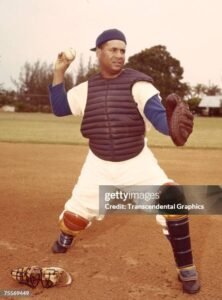
VERO BEACH, FLORIDA – FEBRUARY 28, 1956. Roy Campanella works out the Brooklyn Dodgers spring training facility at Vero Beach, Florida on February 28, 1956. (Photo by Mark Rucker/Transcendental Graphics, Getty Images)
Durocher returned in 48 but the team got off to a bad start. Rickey negotiated a deal with the Giants that allowed Durocher to take over in New York. The 48 team saw the beginnings of the Boys of Summer as Duke Snider and Gil Hodges, a catcher at the time, both saw some playing time. They finished 3rd in the NL. The last year of the decade, Robinson was joined by fellow Negro Leaguers, Roy Campanella, and Don Newcombe.
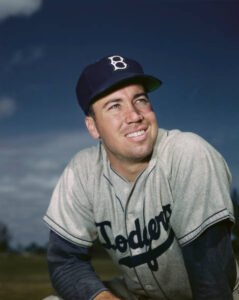
American baseball player Duke Snider
The 49 team, once again managed by Burt Shotton, won the pennant. Newcombe was the ROY. Campanella became the starting catcher with the core of the Boys of Summer now in place. Hodges at 1st, Robinson at 2nd, Reese at SS, Billy Cox at 3rd. Furillo in right, Snider in center and who ever in left. The rotation was Newcombe, Roe, Branca and Barney. They lost the series to the Yankees in five games. But the next decade would bring changes none could have imagined.
1950-57
In 1950, O’Malley bought out Rickey. Smith died and left his shares to his wife. The team was now owned by O’Malley, the Mulvey’s and Mrs. Smith. But the man calling the shots was O’ Malley. The team was in a spirited pennant race with the Phillies that went right down to the wire with the Phillies finally winning the pennant on the last day of the season beating the Dodgers on a 3-run homer by Dick Sisler. Seeking to change things up, they hired Chuck Dressen to be the new manager. Campy was the MVP inn 51, he hit .325. Robinson had a higher BA and a 9.7 WAR. Hodges hit 40 homers to lead the team. But they saw a 13.5 game lead evaporate as the Giants made a historic charge. They ended up tied and had a 3-game playoff. They lost game 1, 3-1. They won game two, 10-0. Newcombe pitched game three and went into the ninth leading 4-2. But Newcombe tired and with 2 on and 2 out, Branca came in to face Bobby Thompson, who had homered off of him in game 1. Thompson hit a pitch deep into the left field seats at the Polo Grounds and the Giants won the pennant.
Dressen would lead the Dodgers to back-to-back pennants in 52-53. They would lose both times to the Yankees. Campanella won his second MVP in 53. After the 53 season, Dressen demanded a multi-year deal. O’Malley refused and hired his AAA manager to manage the team, Walter Alston. They finished second in Alston’s first year as the Giants went on to beat Cleveland in the World Series. 
The 1955 team came out of the gate breathing fire, winning their first 10 games. They won 22 of their first 24 and never looked back. They won the pennant by 13.5 games. Campy would win his 3rd MVP award. Snider hit 40 homers for the third time in a row. They slugged 201 as a team. Newcombe won 20 games. No other starter won more than 11. Labine won 13 out of the pen. They went to the World Series for the third time in four years. This time, things went much differently. They lost the first two games at Yankee Stadium, then swept the next 3 in Brooklyn. They lost game six, 5-1 to Whitey Ford. Game seven was started by Johnny Podres against Tommy Bryne. Podres, who won game 3 in Brooklyn, shut down the Yankees bats. But there was a critical point in the game in the sixth inning. Sandy Amoros had been sent into left field as a defensive replacement for Jim Gilliam. With runners on first and second and one out, Berra hit a line drive down the left field line. Amoros raced towards the line stuck his glove out and made a game saving catch. He then relayed the ball to Reese who fired to Hodges for a double play. The final out of the game was a grounder to Reese and Brooklyn had their first and what would be their only World Series win. Podres was named the MVP of the series.
For the second time in his career, Duke Snider hit 4 homers in a World Series. Yankees star Mickey Mantle was injured and only played in 3 games. Brooklyn would win the pennant again in 1956. Newcombe would win the MVP and the Cy Young award in its initial year. The Yankees reversed the outcome this time. Winning in 7 games. Don Larsen pitched a perfect game in game 5. The first and only such performance in World Series history. Labine kept them in the series with a 1-0 win in game six, but the Yankees pounded Newcombe in game seven. Jackie Robinson retired after the season when he was traded to the Giants.
Behind the scenes, things were not good in Dodgerland. O’Malley wanted to build a new ballpark to replace Ebbets Field which was in pretty bad shape. But his feud with Robert Moses, who ran New Yorks building commission, ended up with O’Malley deciding to move the team west. He talked Horace Stoneham into moving the Giants west also. 1957 would be a very somber year in Brooklyn. They finished 3rd, 11 games out of first behind the Braves.
Their 67 years in Brooklyn came to an end. Things would be much different in Los Angeles.
MiLB GAME SUMMARY REPORTS
OKC Comets 7 – Albuquerque Isotopes (Colorado) 2
This was an OKC bullpen game. Garrett McDaniels, Nick Frasso, Paul Gervase, and José Rodríguez each completed 2.0 scoreless innings. McDaniels allowed a pair of hits, 2 BB, and 3 K. Frasso allowed 1 hit, 1 BB, and 3 K. Gervase retired all 6 batters he faced including 2 on K. Rodríguez retired all 6 batters he faced and struck out 3.
OKC got on the board 1st with a run in the 4th. CJ Alexander led off with a double, moved to 3rd on a ground out, and scored on a Ben Rorvedt sac fly,
The Comets picked up a pair in the 5th. With 2 out Esteury Ruiz singled, stole 2nd, Ryan Ward drew a BB, and Alexander plated both runners with his 5th triple.
CJ Alexander with hit No. 3️⃣ and Comets run No. 3️⃣ tonight on this 3️⃣ bagger down the line! pic.twitter.com/bH8d8ksDRO
— Oklahoma City Comets (@OKC_comets) August 16, 2025
OKC picked up an insurance run in the 7th. Noah Miller singled, moved to 2nd on a Ruiz BB, and scored after Ward reached on an E-6.
The Drillers picked up 3 insurance runs in the 8th. With 2 out, Gauthier reached on an E-5. Kody Hoese hit a ground rule double (21). Both runners scored on a Noah Miller single. Esteury Ruiz singled with Miller going to 3rd. Miller scored on a fielders choice and dropped ball on a throw.
In the 9th, Will Klein allowed a hit, 3 BB, and surrendered a pair of runs (1 earned) before Zach Penrod came in to get the final out.
- CJ Alexander – 3-5, 1 run, 2 RBI, double (16), triple (5)
- Esteury Ruiz – 2-4, 1 BB, 1 run
- Noah Miller – 2-4, 2 runs, 2 RBI
- Kody Hoese – double (21)
Tulsa Drillers 8 – San Antonio Missions (San Diego) 5
After 2 exceptional starts, Roque Gutierrez looked to continue the dominance. He allowed 4 runs on 5 hits and 2 walks before getting pulled after 0.2 IP.
Tulsa answered in the bottom of the 1st. Zach Ehrhard hit a one out triple (1). Kyle Nevin and Chris Newell followed with walks. Yeiner Fernandez hit a bases clearing double (14) to bring the Drillers within 1 after 1 inning.
Jorge Benitez and Livan Reinoso followed with 2.0 scoreless innings each before giving way to Jacob Meador. Meador allowed 2 singles, a WP, and a run scoring single before inducing a 5-4-3 DP. The Missions took a 5-3 lead.
In the bottom of the 6th, Damon Keith hit a one out single and moved to 2nd after a Fernandez BB. Griffin Lockwood-Powell hit a 2-run double to tie the game. Taylor Young followed with a run scoring double of his own and a 6-5 Tulsa lead.
In the 7th, Ehrhard led off with a double (4), and moves to 3rd on a ground out. Keith drew a 2-out walk. Ehrhard scored and Keith moved to 2nd on a WP. Keith scored when Fernandez reached on a E-5 throwing error.
Christian Suarez and Carson Hobbs pitched the final 2.2 scoreless innings, with Hobbs earning his first AA save. He has been nothing short of dominant since being assigned to Tulsa.
Carson Hobbs continues to plow through Texas League hitters. Hobbs threw a scoreless inning last night and has yet to give up a run in his 7 outings with Tulsa, which spans 10.1 innings.
— Dodgers Daily (@dodger_daily) August 15, 2025
His great pitching started way before he got called up to Tulsa, though, as his 1.77 ERA… pic.twitter.com/EwPkRSqjA3
- Zach Ehrhard – 2-3, 2 BB, 2 runs, double (4), triple (1)
- Damon Keith – 2-3, 1 BB, 2 runs
- Doubles – Yeiner Fernandez (14), Griffin Lockwood-Powell (8), Taylor Young (19)
Great Lakes Loons 16 – Wisconsin Timber Rattlers (Milwaukee) 5
The Great Lakes Loons smacked four home runs and scored 16 runs on 16 hits in a drubbing of the Wisconsin Timber Rattlers 16-5.
Logan Wagner led the team with 4 RBI’s. He added to his lead in the clubhouse with his 14th homer of 2025. He slugged a 3-run HR in the 7th that went 427 feet and 106 mph off the bat.
Jake Gelof homered for the third straight contest, his fourth of the week. The 23-year-old put the Loons ahead 6-4 with a two-run homer, sent 400 feet, with a 107 mph exit velocity. All four of Gelof’s homers have been blasted beyond the left field fence.
Eduardo Quintero had his first longball as a Loon in the first inning. Quintero rocked one to straightaway centerfield, 414 feet. The 19-year-old now has 15 on the year.
Eduardo Quintero dingers 🤝 High-A
— MLB Pipeline (@MLBPipeline) August 16, 2025
The @Dodgers’ No. 4 prospect — at just 19 years old — swats his 15th roundtripper of the season, first for the @GreatLakesLoons: pic.twitter.com/Ffi7fktjmZ
Kendall George had his third straight multi-steal game, taking three tonight. George now has 11 this series, besting his franchise record for most stolen bases in a series, 10, achieved twice this year. He scored from second base on a groundout to short. After getting to third, he paused, and after Wisconsin shortstop Luis Pena threw it to first, George broke home and slid in ahead of a toss.
Elijah Hainline and Carlos Rojas each had three-hit nights. Hainline had a solo homer in the fourth and an RBI single in the ninth. Rojas roped three singles, driving in a run in the sixth.
The Loons bullpen combined for 4.1 scoreless innings, striking out nine. Joseilyn Gonzalez inherited runners on the corners and a two-run lead in the fifth. The right-hander worked out of it, and he earned the win. Ryan Brown, Alex Makarewich, and Cam Day each tossed a scoreless frame, with multiple strikeouts.
With Maddux Bruns on the mound to start the game, Wisconsin’s Luis Pena powered out a three-run home run in the second inning, his second dinger of the series. A first-inning RBI double by Luiyin Alastre and a fifth-inning RBI double by Blyberg Diaz tallied the other two runs. In 4.2 IP, Bruns allowed all five runs (2 earned) on 8 hits and 2 BB.
Zyhir Hope had a two-hit and two-steal night. It is Hope’s second straight game with two stolen bases and two knocks.
Rancho Cucamonga Quakes 13 – Visalia Rawhide (Arizona) 6
A five-run first put the Quakes in the driver’s seat on Friday night, as they cruised to their third straight road win over the Visalia Rawhide, 13-6.
Jaron Elkins had four of Rancho’s 17 hits, as the Quakes saw three players with at least three hits in Friday’s win.
The Rancho offense exploded early, scoring five times against Visalia starter Adonys Perez to take a commanding 5-0 lead in the 1st.
Quakes’ starter Marlon Nieves uncharacteristically struggled with his command on Friday, as he walked two first-inning batters. Both scored on a two-out double from Trent Youngblood, as Visalia made it 5-2 after one full inning.
Elkins reached and then scored on a balk by Perez in the second, as Rancho upped the lead to 6-2.
They added three more and chased Perez (7-6) in the third, taking a 9-2 lead.
Leading 10-5 in the eighth, Rancho put it away with three more to go up 13-5.
Angel Diaz matched a season-high with three hits and three RBIs, while Victor Rodrigues had two hits and two RBIs. Chase Harlan also finished with three hits and an RBI.
Marco Corcho was credited with the win, after going 1.1 innings of scoreless relief.
The Quakes will send Jesus Tillero to the mound on Saturday night at 6:30pm for game five of the series, as they eye a series-win after having won three of the first four.
- Jaron Elkins – 4-5, 1 HBP, 3 runs, 1 RBI
- Chase Harlan – 3-6, 1 run, 1 RBI
- Victor Rodrigues – 2-3, 1 BB, 1 HBP, 2 runs, 2 RBI
- Angel Diaz – 3-4, 2 runs, 3 RBI, 2 doubles (4)
- Ching-Hsien Ko – 2-3, 2 BB, 2 RBI
Born June 14th, 1948, in Los Angeles California. AKA The Bear

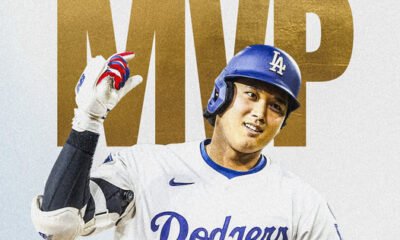



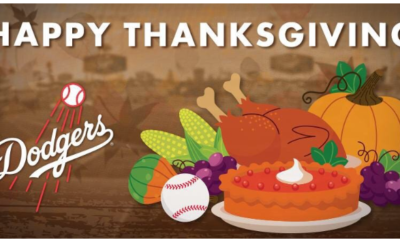







I’ve actually heard the sky as being described as Carolina blue and that’s why god is a Tar Heel fan.
Here in LA, we have no idea what that means. Plus, Duke blue is prettier.
The sky is Dodger blue.
They squeaked this one out. A win’s a win, yes, but the offense was ugly again. 4 for 25 with 11 K’s. With an opportunity to blow it open both Ohtani and Betts made outs with the bases loaded.
The good news is the pitching won this one. Vesia is a concern. Does he need a rest? And what can be done about Muncy and his propensity for injuries?
Kershaw was, once again, clutch. A 37 year old with an 89 mph fastball our ace? It would appear so. I hope other staff members are learning from him.
I really enjoyed this one Bear. A lot of early history I didn’t know. Dodger fortunes really turned around with O’Malley. Thank you.
And a big thank you to Kersh for saving the day. Once again. Snell and Glasnow need to follow suit!
Great article and analysis by Verducci on Dodger issues.
https://www.si.com/mlb/how-the-juggernaut-dodgers-lost-their-way
My favorite detail was the reminder that Casey Stengel was a Dodger…
which could inspire the debate over which former Dodger grew up and became the best manager.
Thank you, Cassidy. It took a lot of time and research.
Bear, your writing style is really nice and easy to read, regardless of topic.
Thanks Bobby. I keep it as simple as I can.
Well done once again Bear. I thoroughly enjoyed it and learned alot.
I appreciate it Ohio. Working on Part 2, Los Angeles. Little easier to remember those.
I look forward to it.
Good analysis.
Mine? The Dodgers had the bases loaded with the HOF billion dollar top of the lineup coming up and what happens? Ohtani is thrown 4 straight balls and he swings at 2 of them, missing both, then grounds into a force play. Mookie then flies out and eventually the inning ends with only 2 runs scored.
This team is not hitting. And I don’t expect Freeland, Conforto, Call and Rojas to provide the thunder. Support yes. Thunder no. That’s up to the top of this lineup.
And we wait.
Muncy. Another oblique. Will he play again?
That was my exact response to Ohtani’s at bat with bases loaded and no outs. Vazquez did not throw a single pitch in the strike zone. Dodgers ended up with a run but I do not think it was a good at bat. I know it sounds like quibbling but Ohtani had been showing more patience over the past few days until that at bat. Should have had bases loaded, a run in, and no outs.
I know the Dodgers will take the team option on Muncy for ten million next year but he has missed a lot of baseball games these past two years. 73 games last year and only 89 games to date this year. Maybe they pursue the 25 year old Japanese third baseman and sign Muncy. But older players, more injuries.
And the Angels go back to being the Angels after sweeping us. Still can’t get that out of my craw
Well, the Angels were hung over from celebrating going 6-0 vs us, so you can’t blame them for this one. They will be hanging the “we beat the Dodgers” banner this weekend.
Great performance by Kershaw!
Clayton showed again that he is the best player in Dodger history. In the most important game of the year, Clayton shut down the red hot Padres and put the Dodgers back into first place. His third consecutive quality start in August. Without Kershaw this month, the Dodgers would be 4 games out and hoping for a wild card berth.
The offense managed to turn a couple of two strike ground balls and a bunt into two runs. Teo had a big hit and the bullpen held together.
The top four batters for each team were a combined 0-26! That is 6 likely hall of fame players and two all stars going hitless.
Hopefully this is a turning point for the season as the pressure will shift to the Padres.
Best player? Hardley. Best pitcher? Possible. But Koufax was nails in these kinds of games.
Koufax was great especially his last five seasons and especially in World Series. But Kershaw has had 15 years of a 3 era or lower while Koufax only had 5 seasons. Everyone can have a different opinion on longevity vs short term dominance. I think Kershaw provided both.
I would be interested to know who you rate as the best all time Dodger players if not Kershaw. Maybe a good column someday. It is even harder to compare pitchers to position players.
I’m sure my comment will stir the nest some but here goes anyway.
Kershaw is my Hero. What a warrior. He just competes. He was great in a very meaningful game. If Kersch goes out there and gets lit up, it’s a huge deal for the Padres confidence. Instead he showed up big time.
So, if I may asked, why didn’t Doc send him out for the 7th. Yeah, I know get him out while the getting was good. Good feelings all around? Yadda – yada……He didn’t look fatigued at 76 pitches. He’d lost nothing. Did he ask out? I bet not.
I understand all the reasons why it was a swell time to pull him except ONE. We need innings from our starters due to our spend bullpen. And this was a very good opportunity to milk an inning.
Send his ass back out there for the 7th after the conversation w/ Doc making it clear that he has ONE Guy, at a time. If one opponent batter gets on, you’re pulling the plug. Have Casparius ready to go in that case. Maybe Casparius would like to start a fresh inning but I’d like a trip to Paris. If all goes well,, his clean inning could be the 8th and not the 7th.
This isn’t April. It’s the stretch run and Kersch wasn’t done at 76 pitches. Trust the man and send him out there for the 7th
If Doc did what I wanted from my recliner the Dodgers might have lost. I wanted Kershaw to go one more inning and I would have left Trienen in.
Like I ranted on this topic a couple of days ago and a few times in the past of removing pitchers a inning or two too early so they’re fresh for the postseason. To me, it’s complete bullshit. This fantasy thinking by Roberts and the front office has NEVER been validated on the field. Either the starters get injured or the BP is overworked by the end of the regular season. And the starters aren’t injured because of pitching too much.
To the contrary, they throw too hard and not enough. I think muscles, tendons, and ligaments are strengthen by being used often and reasonably. Common sense.
And to encourage chase by a hitter instead of pitching to a hitters’ weakness. Complete madness.
It seems the organization has no respect for a pitchers’ arm. Maybe they think “we can afford to buy more, find more, development more arms”. From hundred million dollar free agents, to the farm, to the DFA junk pile the supply is unlimited.
How does a starter remain competitive if he rarely is put into a competitive or challenging situation?
The explanation from Doc after the game? He is going to be pitching in Colorado next week. The last time he was in Colorado was June 26. He went 6.0 innings, 69 pitches, 1 run, 2 hits, 1 BB. It is almost like he gets pulled after 6.0 regardless of the number of pitches. His last three starts: 6.0 innings (88 pitches), 6.0 innings (74 pitches), 6.0 innings (76 pitches). He has gone 7.0 once this year, and has thrown 100 pitches, although that was so he could get his 3,000 K at home vs CWS. He has averaged between 12-13 pitches per inning his last two starts, and less than 15 the start before.
Doc said later he pulled him early because his next start is in Denver. Saw a post on the yahoo sports stream by one of the Dodger blogs pushing for the Dodgers to cut ties with Conforto and give Ward a chance. Jacob Amaya was DFAd by the White Sox.
I think maybe they want him for October and to get him there they must restrict his pitch count.
Badger, I get that statement. And still call bullshit. This is SO DOC.
So it’s a foregone conclusion that if you want Kersch around for October he MUST restrict his pitch count? By what, 15 pitches?
I’m not convinced that’s true. Again, if he gets one hitter on base, pull the plug.
And in the next paragraph we can read that the Dodger starters need to go deeper into the games. Well, let them.
I agree. He was dominating, PLUS our bullpen has been quite scary lately.
Plus, we know it’ll take Snell 100 pitches to get thru 5 innings today, and we’ll need to use a few bullpen guys after him.
James Outman has just been recalled by Minnesota’s AAA team in St. Paul. My wife asked why he was sent to AAA with Buxton out and Bader traded. I obviously had no knowledge, but I guessed, maybe they want to change his swing.
He started out very poorly in St. Paul, going 2-21 in his first 5 games. In his next 7 games: 34 PA, 30 AB, 10 hits, 2 doubles, 1 triple, 3 HR, 8 RBI, 4 BB. That works out to be a slash line of .333/.412/.767/1.179.
As my wife said, now it is up to him. There is obviously less pressure.
Great to read this update about Outman.
Rooting hard for him to succeed.
It would be sweet if he gets a third Dodger WS ring when the Twins visit LA next season.
He’s a center fielder and Buxton has that spot. I just offered Conforto and cash to cover his salary plus Kim plus Robert’s left big toe to get Outman back.
I hope he does well. Always liked him. If they can fix him, then maybe they could fix Conforto next year. He will be cheap.
Another thoroughly entertaining article Bear. Just a small period in Dodger Baseball History from 1884 to 1957 and the move to LA. And a belated Congrats to Bob Caruthers on another 40 win season in 1889 and Oyster Burns’ 13 dingers in 1891ish. It seems I started recognizing more names in the late 1930’s, forward.
I’m not a collector of autographs or baseball cards. I have 4 autographed balls; a Willie Mays I got from Willie himself which is quite a story, a Brooks Robinson, Tony Gwynn and a Buck O’Neil. I did have a box of cards we played a board game with. I never put them in the spokes of a bicycle. I had all the famous ones but like many of us, my box of cards disappeared somewhere throughout all my travels.
What I do collect is ball caps. And they all must have to have some significance. They have to be fitted caps, size 7 5/8. New Era. No golf hats with an adjustable strap. And NO fish net, trucker’s caps! I will sometimes go with the lower crown.
I especially like Spring Training caps that are different. I have an A’s cap from a few years ago that had the White Elephant as the logo. This one starts conversations about the White Elephant. I have many different Dodger caps, especially the World Series Cap with Gold Piping. I had to have the traditions Cardinals cap with the classic Bird on the Bat logo on dark blue with the red bill. I guess I have maybe 200 caps or more, each having some special significance.
My current favorite caps are authentic fitted wool caps with a leather band from The Negro Leagues. They are purchased through Ebbets Field Flannel out of Seattle. They used to have a warehouse to visit but now I think it’s online catalog orders only. No current MLB stuff but vintage jerseys and caps from MiLB, Negro Leagues, foreign teams etc.
The Negro League cap collecting started some years ago when I had a vintage black wool 1939 Homestead Grays cap. An ex-girlfriend made off with that one. I don’t miss her but I sure miss that cap.
I currently have a few select wool replica caps. A 32-35 era SF Seals, Joe DiMaggio replica, a 1942 Sachel Page, KC Monarchs classic white with dark blue and red piping, and 2 different caps from the Chicago American (Black) Giants; one a 1914 gray and black short bill model and the other a 1926 Black classic black with gray piping. In tribute to my Canadian snowbird neighbors in Phoenix, I also have a “Moose Jaw” 1940’s Hockey cap. I only have 1 cap from the City Connect uniforms but the current LA cap with the script “D” is very similar to the Dodgers 2017 Spring Training cap.
I always have an eye out for something different.
Thanks again Bear for a fun journey through Dodger history until the move West. Can’t wait for Part 2..
Oh yeah, I started collecting some reprints of Negro League stars. I have Josh Gibson and Cool Papa Bell. I would love to go to the Negro League Museum in KC. That is about 544 miles away. Would take a day to get there. If I get the time and money, I am going to do that. LA has 40 games left.
I do not collect ball caps, but, I have one that I truly cherish. I was at Vero Beach for Spring Training in the early 90’s. I just happened to wear my Brooklyn hat that day. I happened to run into Ralph Branca an he autographed my hat. I miss Vero Beach.
Thanks Phil. I collect some things, mostly blu-rays, movies, cd’s. I have well over 100 bobbleheads, but I have no more room. This is a one-bedroom apartment. I have 3 bookcases with bobbleheads and models on them. The models I build. It relaxes me. I do have some baseball cards. The older ones are usually reprints. The originals are way to expensive for my blood. A Koufax rookie can sell for thousands. I also have about 4 cards that are ceramic. Really cool, but fragile. Have a Berra, Hodges, Robinson and even a Satchel Paige when he was with the Browns. Those are from the 52-53 Topps set. I do have every 1959 Dodger Topps card that are all original. I don’t have the team card. Was never into those. Most expensive of those was the Koufax. 15.00$. My models run the gamete, but all are military. Made a USS Arizona but used decals that made it into my dad’s ship at Pearl Harbor, the Nevada. So instead off BB-39, it is BB-36. Built Richtofens tri-plane. It’s a real Fokker. Sorry, bad pun, could not resist. Have the Memphis Belle, a A-1 Abram’s tank. A Sherman from WWII. Various fighter planes from all wars. A couple of carriers including the Hornet with Dolittle’s B-25s on board. I am working on a USS Enterprise super carrier and the USS Indianapolis, the ship that took the A-bomb to Tinian. I have about15 baseball caps of the Dodgers including the Brooklyn cap they wore on Jackie Robinson day with the 42 on the side. A couple of their military caps they were on Armed Forces weekend. I have several jerseys. Bellinger, Kersh, Gibson, Robinson, Koufax, Gonzalez, Freeman, and a camo Seager. I have well over 3000 movies on disc and blu-ray. I also have some historical figure bobbleheads. Two of them are John Wayne. But I have several presidents and Benjamin Franklin. I have about 900 music CDs. Not all of them are country. Some oldies and classic rock in there. Movie themes, and two musical plays I really enjoyed, Phantom of the Opera and Jesus Christ Superstar. Original cast, not the movie stuff. And then there is my music equipment. And I have a lot of that. I am working on Part 2. Have a great weekend.
Very cool Bear. I built lots of models when I was young. The Aurora monster models. Dracula, Frankentein, The Mummy, Phantom of the Opera, and Forgotten Prisoner. Also Batman and Superman. Then I got into military models. I loved Battleships. Built the Missouri and Arizona. Also the Constitution. My favorite model is a P-38 Lightning. What an incredible airplane. And then the SR-71 Blackbird. After my military modeling I got into cars after I started to drive. 69 Chevelle is my favorite and also my first car. Great memories. You are truly a renaissance man.
I built the Munster coach and Dragula. I thought they were totally cool.
For years I bought those AMT model car kits. I also would build cars to look like the old Jalopy’s that used to run at Gardena speedway and Ascot Park. Termite Snider was my favorite drive. He drove a 32-Ford Sedan with a 283 in it. I have built the Missouri, Arizona, Graf Spee, Yamato and the Bismarck.
Great stuff Bear. My departed Uncle George from my Mom’s side was an interesting character and a skilled model airplane builder. He got polio at age 11 and spent 2 years in an iron lung. He was left handicapped with a hunchback, deformed right arm and left leg. While in the hospital, he became fascinated with airplanes. Later he became an aircraft engineer and developed on his own time what now would be an ultalite craft. He ran the airport in Stockton and served on the CAP. He modified his 2 airplanes to accommodate his handicap. He had the most unique group of friends ranging from a former Blue Angel pilot, a pilot who flew Bobby Gentry’s plane, a crop duster and a female who became the first female 747 co-pilot in the orient. I loved rubbing elbows with his friends. I wanted to talk about flying and they wanted to talk baseball with me.
George was a huge baseball fan. At his draft board, he would wear one of those half Dodger and half Giants hats, while listening to games on the radio. I did manage to get him into Candlestick twice to see the Giants host the Dodgers. I have never seen a man enjoying being at a live game after all that listening, more. It was a highlight of my life.
In his spare time he made or assembled model planes and a few other military ships and vehicles. He carved some from balsa wood and plastic kits. Each were painted to exact specs. They were perfect. Many hung from the ceiling of his home and office.
When he died, my parents donated his extensive model collection to Travis Air Force Base where they dedicated a portion of their museum for his collection. It’s likely long gone by now. He was quite a guy. Someone you would have enjoyed Bear.
I agree. Love that kind of stuff. My mom worked at Northrop in Hawthorne in the late 50’s. They used to give us kids models by Revell of the stuff they built for the military, like the Snark missile, and the F-89 Scorpion fighter.
This is just wrong, two Dodger fans were arrested Wednesday at the Big A for beating up an Angel fan wearing a Trout jersey. Both were arrested. The victim was taken to the hospital. One of these idiots charged with felony assault. The other misdemeanor assault. There is just no cause for that kind of stuff.
Great stat.
And Snell just improved his ERA today.
Of course we should expect that from Snell, given his contract and the slow-play approach he’s had this season. But with old man Kershaw (who is actually a few years younger than Verlander and Scherzer) has surpassed expectations in maturing into the artful Dodger of this rotation.
Today’s game had a couple of statistical highlights:
–The first five Dodgers to get walks–Shohei and Will twice, and Mookie once–all came around to score. The Dodgers built a 5-0 lead even though the Pads were out-hitting them. (Shohei picking up the pace on his path to 150 runs. Would love to see 162.)
–The Pads had trouble scoring because Will Smith gunned down Tatis, Machado and Bogaerts trying to steal. Dills has really improved on this skill while leading the league in BA and OBP.
Kudos to Conforto for two hits and two RBI. A strong finish would be nice.
That’s truly remarkable. He’s definitely in my top five all time favorite athletes
And he’s a better person than he is a ball player.
Makes me even happier I went to the 3,000k game. Was an honor to be there
DC requests release waivers on Nathaniel Lowe. Hader out until probably the playoffs. Duran dodged a bullet with no major injury after being hit by a comebacker off the bat of DeJong. Pirates are moving Heaney to the bullpen.
I’m actually really excited to see this Cease-Snell matchup tonight.
I’ve been wanting to see Blake Snell in a huge game, and this is as huge as it gets in August.
Also, what happened to the earlier posts today? Sam posted about his Carolina blue sky, and I was messing with him talking about Duke blue.
I thought you were a raisins fan
In fact, a week from today I’ll be in Kansas watching the Raisins
What is a raisin that you will be watching in Kansas? Where in Kansas?
I’m a Fresno St alum, and we open the season next Saturday at Kansas.
So I”ll head out to Salina, Kansas this week, and we’ll make our way to Lawrence Saturday. I was told Biemers for some good Kansas bbque?
I’m usually in Lawrence but my main home is in Western Kansas. Briggs barbecue in Lawrence is great and so is Dickies. If you go to Massachusetts street, go to the Sand Bar, part owner and manager their is 7′, I was his high school coach, he. played for KU. I’m told if you mention my name he will treat you to a beer. I’m not sure that still applies.
Went to Wisconsin to watch a friend umpire and they happen to be playing the Great Lake Loons. We all know that Kendall George can steal bases but what I didn’t gather until watching him live is how he impacts the game. He was on base all the time twice was just pure speed and then the next hitter sees nothing but fastballs which Quintero hit one that had to be over four hundred feet yesterday. George caused a balk, and the whole atmosphere of the stadium changes when he’s up and especially when he’s on base. I hope he can hit enough to move up the ranks because he truly is a game changer.
He plays like Willie Davis but with more steals.
Hits and throws like Juan Pierre who unfortunately drove me crazy.
Wasn’t it about Pierre who Tommy said, if you don’t like Juan Pierre you don’t like Christmas.
Sounds like something he would say.
He’s become my fave minor leaguer to watch/pay attention to
When George is at bat the stadium gets quiet in anticipation. When he is on base everyone sitting near me was saying he’s going to go on this pitch. He didn’t get thrown out in the two games we watched. I think it was fairly close on one steal but the most amazing thing is he scored from second on a ground out to shortstop.
Zack Wheeler to the IL with a blood clot in his upper chest. Outman 0-1 with a K in his game. Brewers down 2-1 to the Reds in the 8th. 13-game winning streak in jeopardy.
Shohei is just 13 Ks away from last year’s total of 162. I love the guy, but I would like to see him cut down on the Ks.
And that would take way better pitch recognition. For all of his talent and accolades, if he had Muncy’s eye he would be even better. He is a sucker for soft away and swings at way too many balls out of the zone. He is so powerful that even a cutdown bat speed would allow him to hit for a better average and hit home runs. You don’t get extra points for hitting a baseball 450 vs 395 in a gap.
Sacrilege, but Ruth was a much better hitter. If Ohtani had Freddies bat to ball skills, he would hit .300 every year. I disliked the guy, but Bonds had amazing eye-hand coordination. Everybody said Ruth struck out a lot, but he never struck out more than 93 times in any season. He averaged 86 per year.
Outman 0-4 in his Twins debut, with 3 Ks. Brewers came back and beat the Reds 6-5. 14 wins in a row.
Snell is still a tough pitcher even when he’s a little off like he was today.
So glad the Dodgers got him.
If Henriquez keeps finding the zone, he’ll bolster this bullpen.